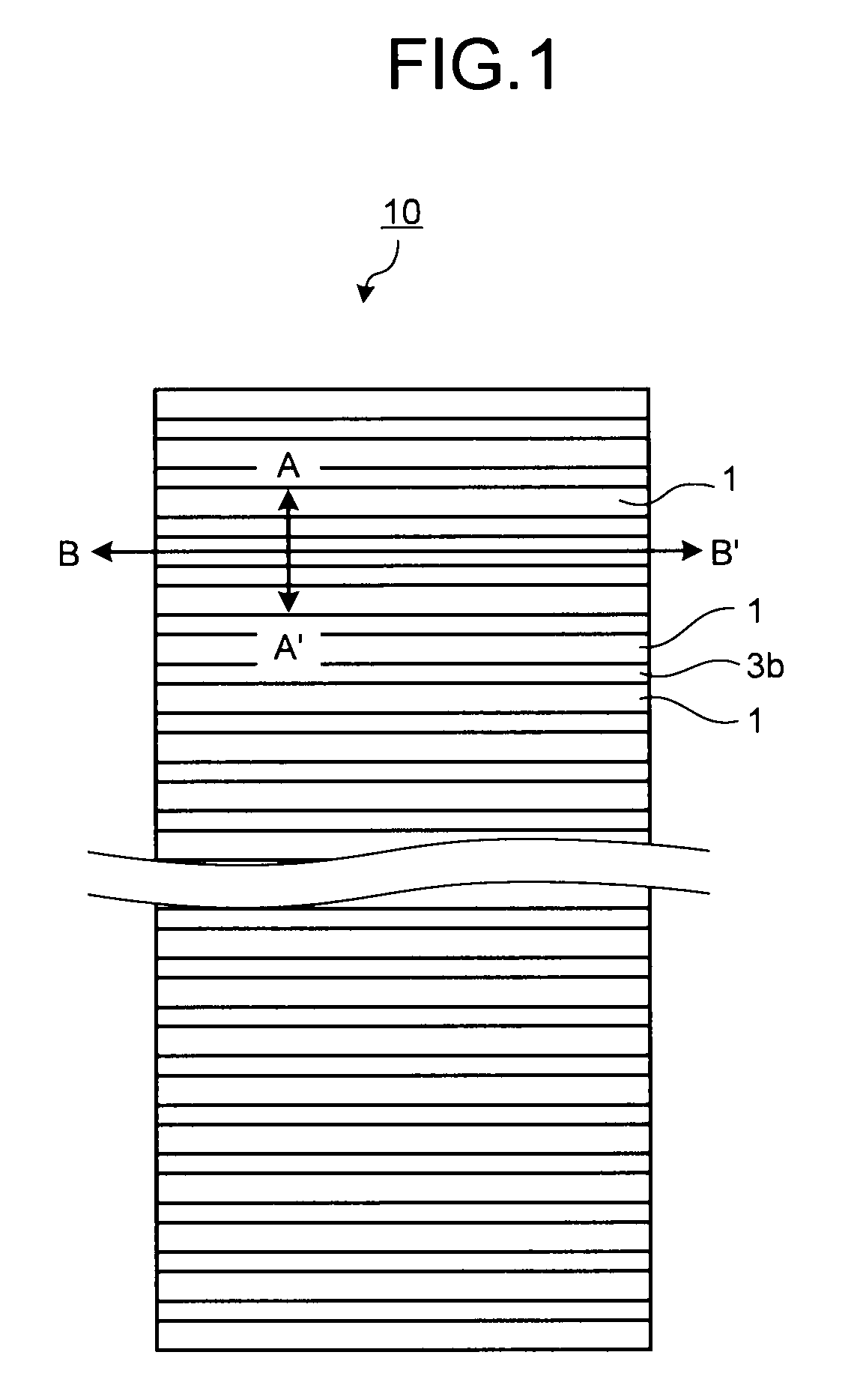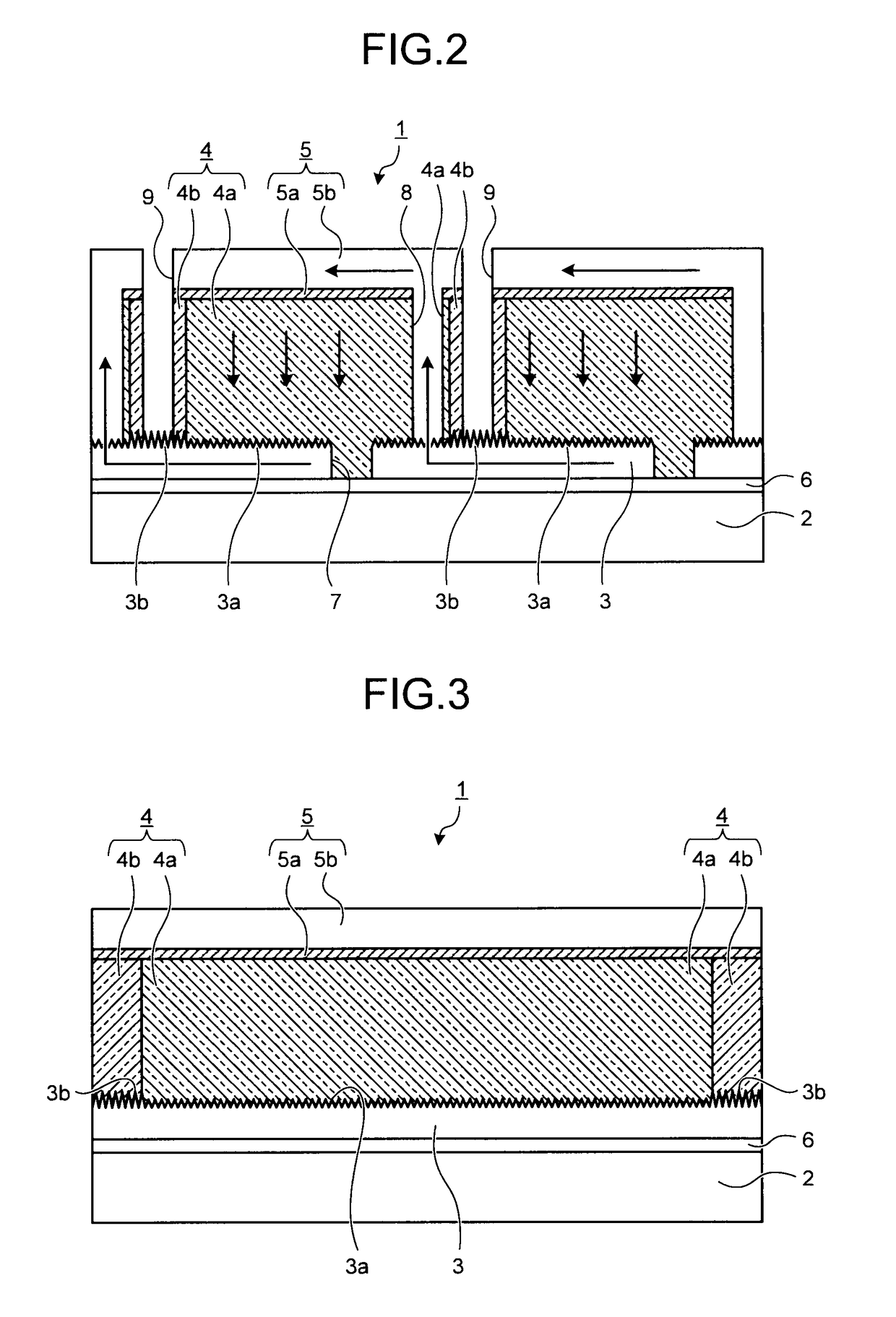Thin-film photoelectric converter
a photoelectric converter and thin film technology, applied in the field of thin film photoelectric converters, can solve the problems of significantly thereby reducing power generation efficiency, so as to prevent deterioration in long-term use, reduce the diffusivity of impurities such as oxygen, and reduce the photoelectric conversion efficiency
- Summary
- Abstract
- Description
- Claims
- Application Information
AI Technical Summary
Benefits of technology
Problems solved by technology
Method used
Image
Examples
first embodiment
[0049]FIG. 1 is a plan view illustrating the schematic structure of a thin-film photoelectric conversion module (hereinafter referred to as a module) 10, which is a thin-film photoelectric converter according to a first embodiment of the present invention. FIG. 2 is a cross-sectional view of a principal part taken along line segment A-A′ in FIG. 1, illustrating the cross-sectional structure of the module 10. FIG. 3 is a cross-sectional view taken along line segment B-B′ in FIG. 1, illustrating the longitudinal cross-sectional structure of a unit thin-film photoelectric conversion cell (which hereinafter may be referred to as a unit cell) 1 constituting the module 10.
[0050]As illustrated in FIGS. 1 to 3, the module 10 according to the first embodiment includes a plurality of strip-shaped (rectangular) unit cells 1 and has a structure in which these unit cells 1 are connected in series. Each of the unit cells 1 has a structure in which a transparent electrode layer 3 serving as a firs...
second embodiment
[0079]FIG. 6 is a plan view illustrating the schematic structure of a thin-film photoelectric conversion module (hereinafter referred to as a module) 20 of a thin-film photoelectric converter according to a second embodiment of the present invention. FIG. 7 is a cross-sectional view of a principal part taken along line segment C-C′ in FIG. 6, illustrating the cross-sectional structure of the module 20. FIG. 8 is a cross-sectional view taken along line segment D-D′ in FIG. 6, illustrating the longitudinal cross-sectional structure of a unit cell 21 constituting the module 20. In the following figures, the same components as those in FIGS. 1 to 3 are denoted by the same reference numerals.
[0080]As illustrated in FIGS. 6 to 8, the module 20 according to the second embodiment includes a plurality of strip-shaped (rectangular) unit cells 21 and has a structure in which these unit cells 21 are connected in series. The module 20 has the same structure as the module 10 of the first embodime...
third embodiment
[0091]FIG. 12 is a plan view illustrating the schematic structure of a thin-film photoelectric conversion module (hereinafter referred to as a module) 40 of a thin-film photoelectric converter according to a third embodiment of the present invention. FIG. 13 is a cross-sectional view taken along line segment E-E′ in FIG. 12, illustrating the longitudinal cross-sectional structure of a unit cell 41 constituting the module 40. FIG. 14 is a plan view illustrating an insulating light-transmitting substrate 42 used in the module 40 according to the third embodiment. In the following figures, the same components as those in FIGS. 1 to 3 are denoted by the same reference numerals.
[0092]As illustrated in FIGS. 12 and 13, the module 40 according to the third embodiment includes a plurality of strip-shaped (rectangular) unit cells 41 and has a structure in which these unit cells 41 are connected in series. The module 40 has the same structure as the module 10 of the first embodiment except th...
PUM
 Login to View More
Login to View More Abstract
Description
Claims
Application Information
 Login to View More
Login to View More - R&D
- Intellectual Property
- Life Sciences
- Materials
- Tech Scout
- Unparalleled Data Quality
- Higher Quality Content
- 60% Fewer Hallucinations
Browse by: Latest US Patents, China's latest patents, Technical Efficacy Thesaurus, Application Domain, Technology Topic, Popular Technical Reports.
© 2025 PatSnap. All rights reserved.Legal|Privacy policy|Modern Slavery Act Transparency Statement|Sitemap|About US| Contact US: help@patsnap.com



